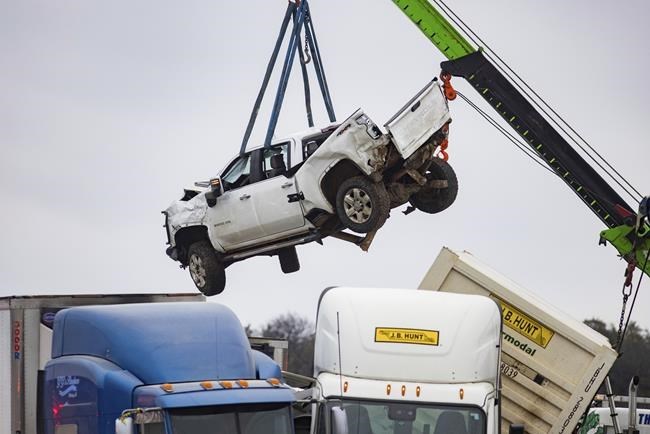DALLAS (AP) — The company responsible for maintaining a Texas interstate where 130 vehicles crashed in icy conditions two years ago, killing six and injuring dozens, failed to address the deteriorating road conditions, federal officials said Thursday.
That portion of Interstate 35 West in Fort Worth was not treated with salt the morning of the Feb. 11, 2021, crash, the National Transportation Safety Board said. The NTSB said that the failure of North Tarrant Express Mobility Partners Segment 3 to address the conditions contributed to the crash, as did drivers' speeds.
The NTSB said that because of the forecasted freezing rain and sleet, North Tarrant Express Mobility Partners Segment 3 had pretreated the southbound lanes of I-35W two days earlier with a liquid brine solution. But, the NTSB said, with precipitation and freezing temperatures continuing, crews checking the road about 45 minutes before the crash didn't recognize that the elevated portion of the interstate where the crash occurred needed additional de-icing treatment.
Before the crash, the area experienced 36 consecutive hours of below-freezing temperatures. On the morning of the crash, crews had spot-treated sections of the interstate with salt but not the portion where the wreck happened, the NTSB said. The agency said that the crews visually checking the road 45 minutes before the wreck didn’t detect any moisture and applied no salt.
North Tarrant Express Mobility Partners Segment 3 spokesman Robert Hinkle said, “Given the extraordinary circumstances, we are confident in the actions taken by the company.”
Hinkle said the company had fully activated its winter storm program and coordinated with the Texas Department of Transportation on best practices, and he noted the pretreatment of the road two days before.
Hinkle said that video footage showed “precipitation began mere minutes before the accident unfolded.” He also noted that hours earlier, dynamic signage began warning drivers of icy conditions and to drive with caution, while permanent signage warned drivers that bridges could ice in cold weather.
The pileup that involved vehicles, trucks and semitrailers began just after 6 a.m. in the southbound toll lanes, which had a speed limit of 75 mph (120 kilometers per hour). Concrete barriers separated the southbound toll lanes from the northbound toll lanes and from the southbound general-use lanes.
The NTSB said that the crash began when a vehicle struck the concrete barrier on the right side of the toll lanes. Other vehicles then began sliding, spinning and striking the barriers. Then a large truck crashed into some of those vehicles, and other vehicles that were unable to stop also became part of the massive crash that blocked all of the southbound toll lanes.
The NTSB said that two of those killed were struck after getting out of their vehicles.
Local officials said at the time that the road was so treacherous from ice that several first responders who responded to the crash ended up falling as they tried to help.
The recommendations from the NTSB include the installation of variable speed limit signs, adding sensors to reduce response times to hazardous road conditions and providing training on how to better respond to winter weather conditions.
In a statement Thursday, TxDOT said it appreciated the “careful and thorough work of the NTSB in looking into this tragic incident."
“TxDOT continuously improves its winter weather operations, and the department has begun to carefully review the analysis and recommendations,” the statement said.
Three days after the crash, Texas’ power grid buckled when another winter storm dropped temperatures below freezing for days. Millions were left without electricity for days, leading to hundreds of deaths.
Jamie Stengle, The Associated Press



